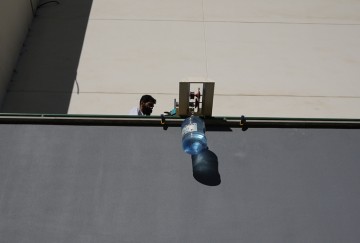Gravity Battery
Version 1
The first in a series of working Newton Machine prototypes, the Gravity Battery is a solution tailored to the vertiginous terrain of Madeira. It comprises a combination of natural materials, which provide a source of energy or a means to store energy, and cultural materials, such as tools, artefacts, and components that are made, recycled, and re-appropriated.

The device is designed to be used with a variety of renewable energy generation methods. In our case, energy (provided by the abundant Madeiran sunshine) is captured by solar photovoltaic panels. This powers a motor, and with the help of a homemade gearbox is used to lift a fixed weight into the sky. When it is needed the energy is released by dropping the weight, which in turn rotates the motor—now a generator—to produce electrical energy. The power available is determined by the size of the dropping mass, the speed at which it drops, and the drop distance. This last element was a key factor in the choice of gravity as a solution due to Madeira's vertiginous landscape and numerous cliff-face communities.

This first prototype re-appropriated lathe gears and an off-the-shelf DC motor. In early testing we discovered that building a good gearbox is relatively difficult, and that efficiency is extremely dependent on tight tolerances and the choice of drive train. While the first iteration showed promise, it required too much mass to turn the gears—in excess of 30kg. We removed one gear train and managed to generate a steady 40W with a mass of 20kg, but it descended too quickly. Some investigation showed that the pulley belt final drive was very inefficient.

The prototype was updated with CNC-machined aluminium side plates to ensure alignment of the lathe-turned bearing holders and a motorcycle timing chain final drive to the DC motor. This last piece was rescued from a scrap Honda VF500, donated by our local bike breaker. We also experimented with bicycle gears, but these were less efficient than the timing chain and gears, which were designed for higher motorcycle speeds. With exactly the same gear ratios as the first iteration, this version comfortably descended with a mass of 10kg.
To test the concept we used a cheap record player situated on the balcony of our institute's café. The record player normally uses an adaptor to convert 220 volts of AC power to 9 volts DC. We built a regulator to limit developed energy. In the first test we dropped 20kg of water held in a typical water cooler container. It played the music perfectly but the drop time was only 1 minute 25 seconds—too short for any song on the album. In the second test we used 10kg of water, but it only generated 6 volts, which was not enough to power the record player.
The third test was just right. We added 5kg to the container, bringing the total to 15kg. Not only did it generate enough power to start the record player, the drop time was just short of 9 minutes; we managed to play the better part of Side 1 of the Johnny Cash album At Folsom Prison.
The beauty of the system is its tangibility—the falling bottle acts as visible feedback displaying how much energy is being consumed and how much energy is left. Turning up the volume resulted in the mass falling more quickly.